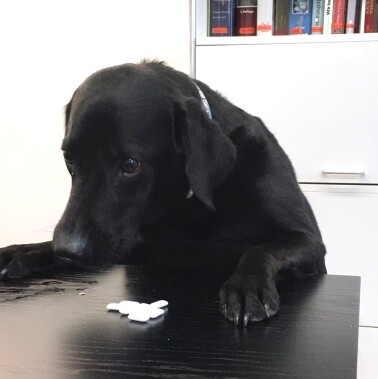While safe for humans, the sugar substitute xylitol is toxic to dogs even in small amounts. Just one chewing gum sweetened with xylitol can cause serious symptoms in our four-legged friends.
Xylitol warning: danger to dogs!

Where can xylitol be contained?
- Sweets: up to 90 % xylitol
- Chewing gum: up to 90 % xylitol
- Nicotine gum: up to 70 % xylitol
- Homeopathic non-sugar globules: at least 98 % xylitol
- Therapeutic nutrient solutions and dental care products for dogs: 2.38 % xylitol
- The following products may contain xylitol: baked products, toothpaste, dental water additives for dogs, etc.
Toxic to dogs
Ingesting just a small amount of xylitol can cause a rapid, dose-dependent insulin increase and a severe drop in blood sugar levels (hypoglycaemia) in dogs. Loss of consciousness, liver damage and death may follow if left untreated.
- Rabbits
- Cows
- Goats
- Baboons
What to do in an emergency
If swallowed:
Treatment is required if ≥ 0.05 g xylitol is swallowed per kg of dog body weight
(or 50 mg xylitol or more per kg of dog body weight).
- Get the dog checked by a vet as soon as possible
(decontamination). - Beforehand – if possible – give the dog something sweet (e.g. honey) by mouth.
The dog weighs 20 kg and the chewing gum packet only states “contains xylitol” (without giving precise quantities).
Estimate the xylitol content per chewing gum:
One chewing gum weighs approx. 2 g. At 90 % content, the chewing gum could potentially contain 1.8 g xylitol.
Calculation: 1.8 g (xylitol) divided by 20 kg (body weight of dog) = 0.09 g xylitol/kg.
Tox Info Suisse’s advice: Take the dog to a vet immediately!
Symptoms (dog)
- Initial symptoms of low blood sugar, e.g. vomiting and weakness, usually occur after 30 to 60 minutes.
- Liver damage can also occur without signs of low blood sugar.
Frequently asked questions (FAQ)
No. Chewing decreases the xylitol content as well as the taste of the chewing gum.
- Once chewed for five minutes, a chewing gum contains on average around 4 % of the original xylitol content of a fresh chewing gum.
- After 15 minutes, a chewing gum contains on average around 0.6 % of the original xylitol content of a fresh chewing gum. However, how much xylitol remains varies greatly from person to person.
- Further information can be found here.
No. Xylitol is not toxic to cats. The chewing gum is usually excreted undigested in the faeces.
According to Clinitox (as at 26/09/23), the following products do not cause low blood sugar (hypoglycaemia): aspartame (E951), cyclamate, erythritol, maltitol, saccharine, sorbitol and Stevia sweeteners.
Prevention
Keep foods containing xylitol out of the reach of dogs.
Further information
- CliniTox database of the Institute of Veterinary Pharmacology and Toxicology in Zurich: www.vetpharm.uzh.ch
- Clini Tox: Giftsubstanz: Xylitol - Kleintier (uzh.ch)
Campbell A & Bates N, Xylitol toxicity in dogs. Vet Rec. 2010; 167(3), 108 & Vet Rec. 167(5), 184
Piscitelli CM, Dunayer EK, Aumann M. Xylitol toxicity in dogs. Compend Contin Educ Vet. 2010; 32(2):E1-4.
Rajapaksha SM, Gerken K, Archer T et al. Extraction and analysis of xylitol in sugar-free gum samples by GC-MS with direct aqueous injection. J Anal Methods Chem 2019:1690153.
Updated September 2023

